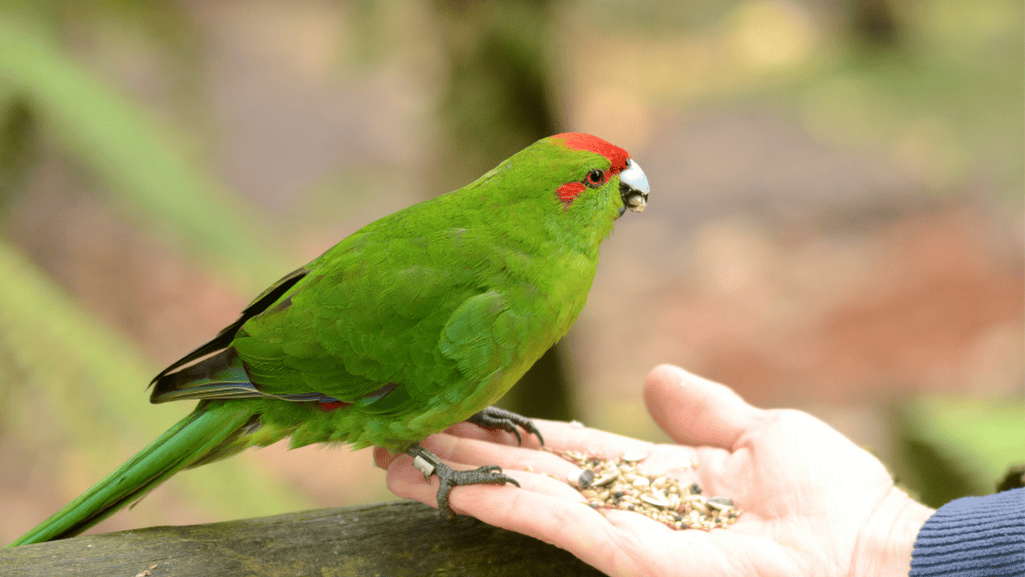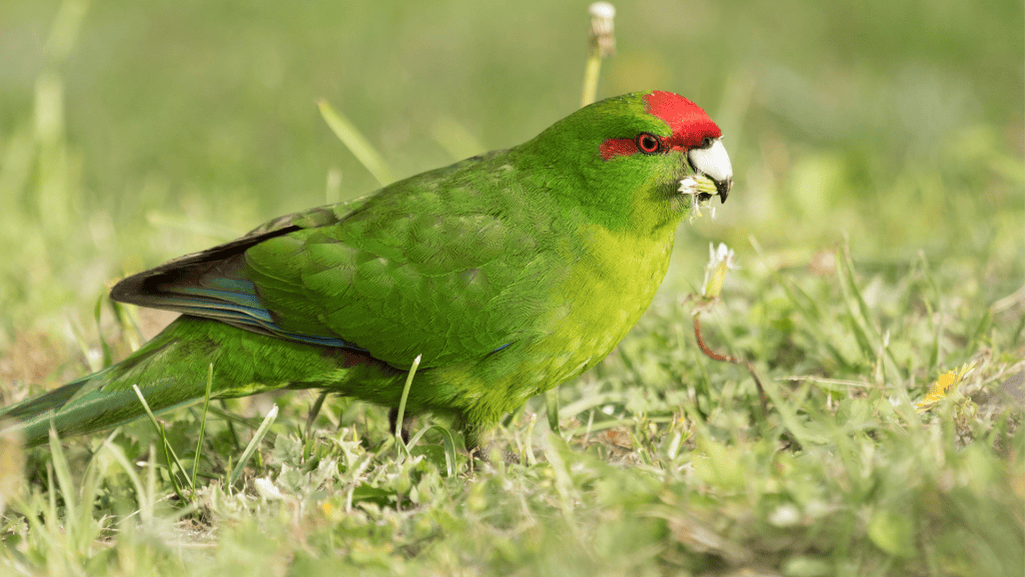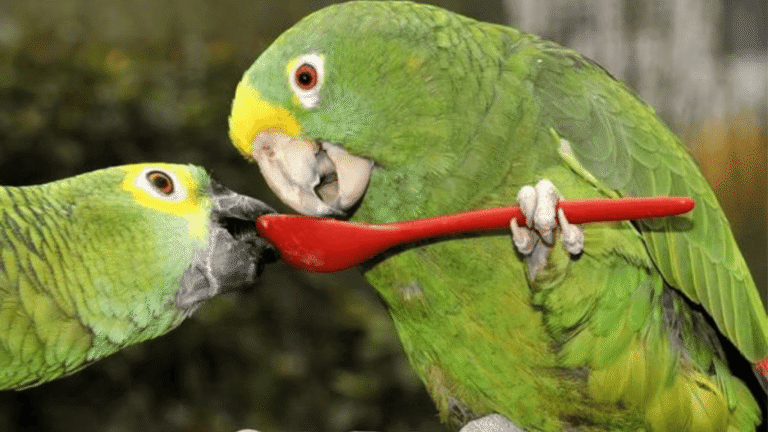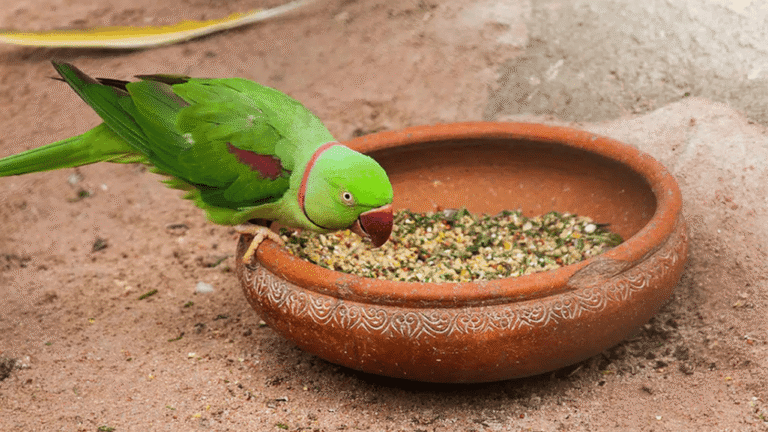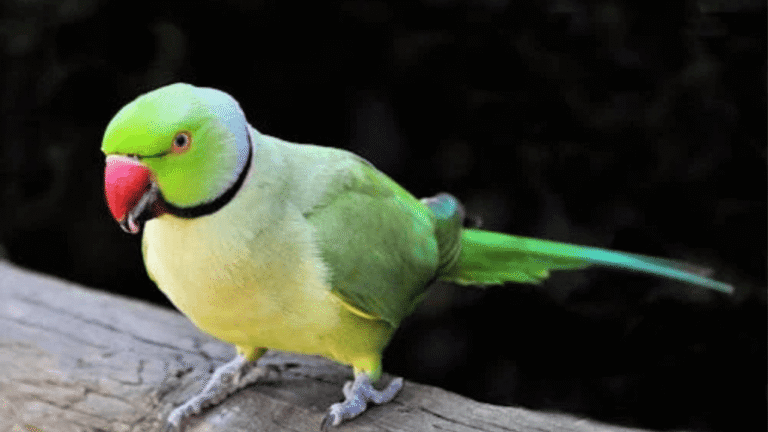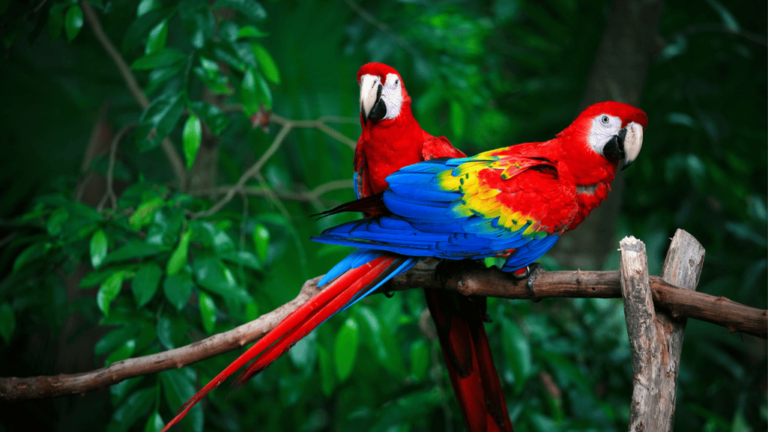Step into the magical world of the Red Crowned Parakeet, a stunning part of New Zealand wildlife. Birdwatchers and avian enthusiasts find this parrot irresistible. Its bright colors and lively actions give us a peek into the world of exotic birds that fascinate us all.
Key Takeaways
- The Red-Crowned Parakeet is a vital part of New Zealand’s avian diversity.
- Observing these exotic birds is a highlight for birdwatching aficionados.
- With their vibrant colors, Red-Crowned Parakeets add beauty to the New Zealand landscape.
- It’s essential to support conservation efforts to protect the species and their habitats.
- Discovering these magnificent birds in their natural habitat is a memorable experience for any nature lover.
- Various tours and nature lodges in New Zealand offer opportunities to engage with these parakeets.
Learn more about the cultural significance and conservation of these birds. Their presence in the wild or sanctuaries shows the beauty of nature. For more insights, explore how cranes and parakeets live together, as seen here.
Introducing the Red Crowned Parakeet
The Red parakeet is known for its bright colors and friendly nature. These bird species are key to the avian world and vital to New Zealand’s wildlife ecosystems.
The Red Crowned Parakeet, or Cyanoramphus novaezelandiae, is found in thirteen regions of New Zealand. Their numbers have grown thanks to conservation efforts. Now, they shine as a symbol of successful bird preservation.
These birds eat a wide variety of foods and adapt well to different places. They live in forests and even in some urban areas. Their small size makes them a joy to see for bird lovers.
Thanks to conservation work, their status has improved. Efforts include protecting their homes and controlling predators. This helps them live safely without threats from animals like possums and cats.
To learn more about these birds, check out their taxonomy, behavior, and habitat. Or, see their conservation status and scientific details on Wikipedia.
Embodying the spirit of New Zealand’s rich biodiversity, the Red Crowned Parakeet continues to soar across the skies, a vibrant testament to effective conservation and the sheer resilience of nature.
The Red Crowned Parakeet is a symbol of nature’s lasting beauty. It shows the importance of protecting our planet’s amazing biodiversity.
Physical Characteristics: A Vibrant Display
The Red Crowned Parakeet is a stunning member of the parrot family. It has vibrant colors and striking markings. Its green body and red head patches create a beautiful picture of nature.
This bird is a symbol of beauty and diversity. Each feather tells a story of survival and adaptation. It fits perfectly into the parrot family’s rich tapestry.
Distinctive Coloration and Features
The Red Crowned Parakeet is known for its stunning colors. It stands out in its habitat and is loved by bird lovers and scientists. The red markings are not just for looks; they help in social interactions and mating.
Size and Comparisons with Other Parakeet Species
The Red Crowned Parakeet is about 28cm for males and 25cm for females. It’s the right size for moving through forests. Compared to others, it fits well in its environment.
This parakeet’s size helps it move easily in different places. It can fly through forests and even in cities, where people love to see it.
- Size: It’s between the Mourning Dove and the American Crow in size. It moves well in its home.
- Physical Build: It has a big head, deep bill, and broad wings. Its short tail helps it fly better.
- Habitat: It lives in dry forests and cities. It’s good at living in many places, showing its adaptability.
In short, the Red Crowned Parakeet’s looks show the beauty of parrots. Its ability to adapt and thrive in different places is truly impressive.
Native Habitats: From New Zealand to Urban Settings
The Red Crowned Parakeet, native to New Zealand, shows how birds can adapt and survive. These exotic birds are known for their bright colors and lively nature. They have made homes in both ancient forests and busy cities.
They are a symbol of the need to protect wildlife habitats. This is true in both remote areas and our cities.
Bird habitat conservation for the Red Crowned Parakeet is all about working together. On islands without predators, they do well. These places are safe havens from city growth and invasive species.
In cities, these parakeets add excitement and a bit of wildness to people’s lives. They remind us of the world outside the city. Urban areas challenge these birds, but they adapt, needing new ways to be saved.
This mix of wild and city life makes our cities better and enriches our lives. The story of the Red Crowned Parakeet urges us to protect these birds. We must ensure they can live in both forests and cities.
Diet and Foraging Habits
The Red Crowned Parakeet is known for its bright colors and interesting eating habits. These birds are fascinating to study, whether they’re in New Zealand’s green landscapes or in homes as pets. Their eating patterns are key to their health and survival.
Feeding Strategies of the Parakeet
Red Crowned Parakeets are great at finding food. They eat flowers, fruits, seeds, and leaves in the wild. They also eat small insects, which are important for their diet. Learn more about their feeding strategies.
Typical Diet in the Wild and in Captivity
In the wild, these parakeets love plants. They eat parts of 57 different plant species. This shows how flexible their feeding habits are and how important a varied diet is.
In homes, it’s crucial to feed them like they would in the wild. They need seeds, fruits, and greens. Sometimes, they get treats like boiled eggs and small bread pieces. This helps them feel like they’re foraging.
Good pet bird care means not giving them bad foods like avocado and chocolate. Instead, focus on a balanced diet full of nutrients. Knowing what they need is the first step to keeping them healthy and happy.
Understanding a parakeet’s diet and behavior is important. It shows how their health is linked to what they eat. Whether they’re in the wild or in a home, their diet is key to their well-being.
Behavior and Social Dynamics
The Red Crowned Parakeet shows a complex mix of social behavior and avian behavior. Their social interactions and breeding rituals are fascinating. These behaviors are key for their survival and reproduction.
Communication and Social Interaction
In the wild, these parakeets use calls and body language to stay connected. Their ability to understand and send signals is crucial for survival. This makes them important in studying exotic pets.
Their communication helps the flock forage, defend against predators, and move through their habitats. This structure is vital for their survival.
Courtship and Breeding Rituals
The breeding season brings out their complex behavior. Breeding behavior includes melodious calls and visual displays. These acts help form and strengthen pair bonds.
These rituals are crucial for their conservation and longevity. They show the importance of courtship in their life cycle.
Understanding these behaviors is key for parakeet care. Supporting these natural behaviors in captivity ensures their health. This is true for both domestic settings and conservation programs.
Observing these behaviors enriches avian studies and our connection with these birds. Whether in the wild or in aviaries, the Red Crowned Parakeet showcases the complex lives of avian species.
The Parakeet in Aviculture: Care and Husbandry
Exploring aviculture opens a world where caring for exotic pets meets specialized knowledge. The Red Crowned Parakeet is a standout, needing a special care approach. This care respects its unique nature and meets the needs of captivity.
Parrot training is key for pet parakeets. It keeps their minds sharp and prevents problems from being cooped up. Training includes teaching commands, encouraging foraging, and using positive rewards. These are crucial for their mental health.
- Pet bird care: Regular vet visits and a balanced diet are essential. The Red Crowned Parakeet needs a varied diet, like the seeds and fruits it finds in the wild.
- Aviculture: Creating a natural environment is important. This includes the right plants, branches for climbing, and safe nesting spots.
- Parrot training: Keeping these parakeets active and mentally stimulated is vital. Toys and puzzle feeders are great for their education and happiness.
- Exotic pets: Understanding the unique nature of the Red Crowned Parakeet helps set realistic care expectations. It also helps with their space needs.
Caring for these exotic pets holistically greatly improves their life and longevity. By focusing on pet bird care and parrot training, owners can make sure their birds not only live but also flourish. This brings joy and color to their lives.
The Red Crowned Parakeet’s Role in Ecosystems
The Red Crowned Parakeet plays a key role in ecosystems. It helps with seed dispersal, which aids in forest regeneration. This bird species also keeps ecosystem balance and boosts biodiversity, supporting wildlife conservation.
These parakeets spread seeds, helping plants grow and spread. They eat from different plants, helping islands like Chatham and Motuhara’s flora to recover and grow. Their actions are crucial for the balance of their ecosystems.
Importance in Seed Dispersal and Forest Regeneration
Red Crowned Parakeets are vital for forests. They eat fruits and nuts, then spread seeds far away. This helps forests grow, which is key for many wildlife species and important for conservation efforts.
Interactions with Other Native Species
Red Crowned Parakeets interact with other native animals, creating a stable ecosystem. They help control insects, acting as natural pest control. They also support native predators, showing their importance in wildlife conservation.
Protecting the Red Crowned Parakeet is crucial for the whole ecosystem. Their decline, mainly due to habitat loss and illegal trade, highlights the need for better conservation efforts. This is essential for the survival of many species.
Conservation Status: Challenges and Efforts
The Red Crowned Parakeet, known for its bright colors, is now at risk. It’s listed as endangered by the International Union for Conservation of Nature (IUCN). It has lost its home in many places. This shows we need strong conservation efforts to protect these birds and their homes.
Threats to the Red Crowned Parakeet
Many dangers face the Red Crowned Parakeet. Habitat loss is a big problem, caused by farms and cities growing. Also, predators and people disturbing them make it hard for them to survive.
Current Conservation Initiatives and Their Impact
Efforts are underway to save these endangered species. These include saving their homes, making laws to protect them, and teaching people about their needs. In South Texas, a small group of parakeets gives us hope. The community’s support and the money made from birdwatching help a lot.
Legislative steps have also been taken. Texas has recognized the Red Crowned Parakeet as native and wants to protect it. This will help keep the birds safe from wildlife threats and habitat loss.
We all need to help save the Red Crowned Parakeet. This includes policymakers, conservationists, local communities, and people worldwide who care about the environment.
Birdwatching and Photography: Engaging with Parakeets
For those who love nature, birdwatching and bird photography are special ways to see exotic birds like the Red Crowned Parakeet. These activities let you see their beauty and help protect them by raising awareness and documenting their lives.
In the quiet of green leaves, avian enthusiasts come together, cameras ready, hoping to see colorful birds. Bird photography is more than just taking pictures. It’s about telling stories, understanding these exotic birds, and caring for their homes.
A great day of birdwatching might mean watching parakeets socialize or seeing how they eat. Every photo you take helps tell the story of bird conservation. This is especially important for birds like the Red Crowned Parakeet, which amaze and inspire many.
Engaging with nature, especially through photography, is more than fun. It’s a deep way to connect with and protect our planet’s amazing variety of life.
- Learning to wait for the perfect light or moment when a parakeet lands on a branch.
- Figuring out your camera settings to capture the bright colors and quick movements of exotic birds.
- Knowing how birds behave to guess their next move, which helps in both birdwatching and bird photography.
- Sharing photos and stories with other avian enthusiasts, which helps us all appreciate and protect birds more.
In today’s world, photos and stories of the Red Crowned Parakeet help teach people and push for conservation. Whether you’re an experienced photographer or just starting with birdwatching, every time you see these exotic birds, you help us understand our world better.
So, birdwatching and bird photography are not just hobbies. They also help protect and appreciate birds all over the world. It’s a hobby that anyone can enjoy, with benefits that go far beyond just taking pictures.
Conclusion
The story of the Red Crowned Parakeet touches the hearts of bird lovers. It shows the ups and downs of wildlife conservation. This bird is known for its beauty and lively nature, making it a favorite in ornithology.
Its biology shows how it can survive despite many dangers. Studies show it has a mean clutch size of 7.0 and faces high mortality rates from aerial predators. This highlights the fine line between life and death for these birds.
Yet, the Red Crowned Parakeet keeps going, even on predator-free islands like Stewart Island. Conservation efforts, like those on Motuihe Island, give us hope. The bird’s ability to find its way home and sometimes appear in cities shows its adaptability.
These traits, along with human help, suggest a bright future for the species. Efforts to save this parakeet help us understand how to keep our planet’s biodiversity. It’s a story of our duty to protect the diverse life on Earth.
So, the Red Crowned Parakeet’s tale is more than just a colorful bird. It’s about our duty to care for our planet’s wildlife. By studying and protecting these birds, we ensure a future for all bird lovers and wildlife guardians.




